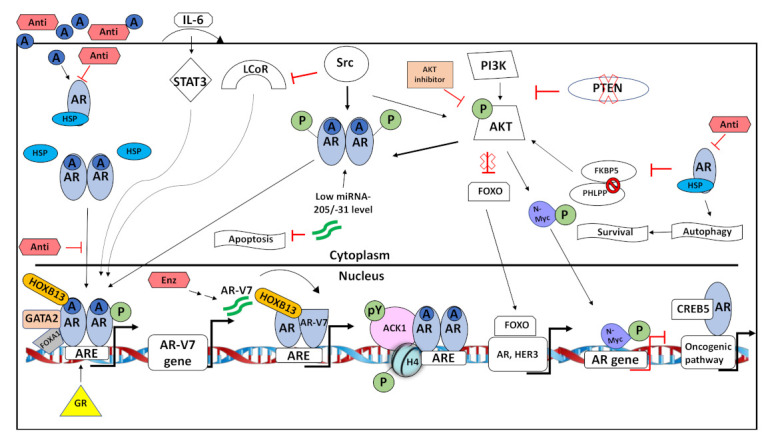Figure 2.

Summary of some adaptive AR signaling pathways active in DRPC. Androgens and AR-antagonists (Anti) diffuse into PCa cells. Androgens bind and activate the androgen receptor (AR) in the cytoplasm. The AR dissociates from HSP, forms a dimer and translocates into the nucleus. Antagonists inhibit androgen-activated AR by various biochemical mechanisms and block activation of AR signaling. At chromatin, co-regulators such as pioneering factors, co-activators and co-repressors modulate transcriptional activity of AR at androgen response elements (ARE). Adaptive signaling that lead to CRPC includes the upregulation of glucocorticoid receptor (GR) that can bind to AREs and can activate AR signaling despite AR inhibition. Through autocrine signaling IL-6 activates STAT3 that in turn phosphorylates AR and thereby enhancing AR-mediated transactivation. The second-generation AR antagonist Enzalutamide (Enz) increases the expression of AR-V7 variant associated with aggressive PCa and dimerizes with AR to change AR transcriptome landscape. Activation of Src kinase phosphorylates AR and AKT. Both Src and AKT interact with AR and phosphorylate AR to enhance its nuclear translocation. Additionally, Src kinase inhibits LCoR and thereby inactivating its function as co-repressor of AR. Low expression of miRNA-205/-31 stabilizes AR protein and blocks apoptosis. Phosphorylated ACK1/AR complex phosphorylates chromatin and increases accessibility to target genes. PTEN loss results in active PI3K/AKT signaling. Active AKT phosphorylates AR and N-myc. Phosphorylated AR translocates to the nucleus and induces expression of ARE. N-Myc represses AR gene expression. AKT inhibition blocks repression of FOXO by AKT. Hence, FOXO is active and induces expression of genes such as AR and HER3. Inhibition of AR by anti-androgens downregulates FKBP5 expression. Therefore, FKBP5 cannot act as a chaperone of PHLPP leading to the hyperphosphorylation of AKT. AR inhibition by AR further induces pro-survival autophagy. CREB5 forms a complex with AR, resulting into expression of genes involved in oncogenic pathways.
